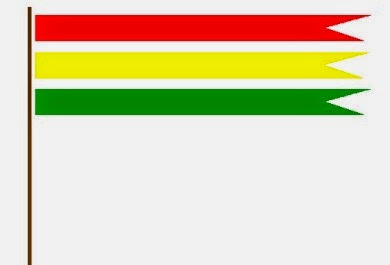 |
| Salagintu Courtesy of Siuala.com |
Pampanga’s
flag has the color of kundiman (red), aluntian (green) and dilo (yellow). The
meaning has varied depending to the perspective of your source.
 |
| Maniago's Military Flag Courtesy of Watawat.net |
Based
on historical accounts, Francisco Maniago has used the color red, yellow
(golden) and green during the Kapampangan uprising of 1660. The salagintu (red,
yellow and green) or sometimes called golden beetle was the color used by the
Kapampangan nobility during the Spanish time. The color of salagintu was also
used by the secular clergy in Pampanga way back then. Even the Christianized festival i.e Apung Iru
Libad in Apalit uses the three colors.
Moreover
there were allegations that the clan of Baluyut, who were in priesthood back
then, used the three colours in their insignia. They also use the salagintu
color to decorate the churches, streets and festivals. Also, the Pamintuan
family used also the salagintu color to represent their clan whether in the
army or in the political arena. Meanwhile in 1950, the Archdiocese of Pampanga
adopted the salagintu color in its insignia.
At
the present, the seal of Pampanga still bear the color of salagintu. Also, the
town of Apalit, Mexico, Sto. Tomas (to name few) has also added the salagintu
color in their official seal.
 |
| Official Seal of Pampanga |
The Significance of
the Salagintu Color
The
following relevance and meaning of the salagintu came from various sources.
Terms:
Kundiman – red; Aluntian – green; dilo/gintu – yellow
(1)
Paroba, Pangulu ampong Bunduk Alaya
The
color kundiman represents the Pangulu (upper Pampanga); the color aluntian
represents the Paroba (lower Pampanga) and the color dilo represents Mt.
Arayat.
(2)
Alti, Danum ampong Aldo
According
to local historian and Kapampangan Culture advocate Mike Pangilinan, the
kundiman of the Kapampangan flag represents the alti (lightning). ‘Alti’ is the
authority/punishment/energy of Bapung Aldo (Apung Suku). Kundiman represents
the color of destruction. Meanwhile aluntian represents the ‘uran’ (rain) and ‘sibul’
(spring of water) which comes after ‘Alti.’ Aluntian represents the water which
heals the land and the people. Dilo represents Bapung Suku/Apung Suku, the
golden sun. Apung Suku is the one who mediates ‘alti’ and ‘danum.’
 |
| Libad Ilug Dela Pas Courtesy of LOI Photography |
(3)
Katapangan, Kasipagan and Kasugian
In
addition to the meaning stated above salagintu color also represents
Katapangan, Kasipagan, Kasugian. These meanings were defined by the Catholic
Church when they adopted the Kapampangan Colors. Kundiman represents Katapangan
(bravery), Gintung Dilo represents Kasugian (nobility). And Aluntian represents
Kasipagan (Industriousness).
(4)
Babo Pampanga, Lalam Pampanga ampong I Yesukristu
In
the website watawat.net, the salagintu color represents Pampanga and Jesus
Christ. Kundiman is the color of Upper Pampanga. Aluntian is the color of Lower
Pampanga and Dilo is the color of Christ.
(5)
Alta Pampanga, Bajo Del Pampanga ampo deng Dayatan
The
colors’ of the Flag of Pampanga has another meaning. Kundiman is the color of
the Alta Pampanga (Upper Pampanga). Red was given to Alta Pampanga due to the
color of the soil and their product – sugar. On the other hand, Aluntian
represents Bajo Del Pampanga. Aluntia is Bajo Del Pampanga’s color due to the
abundance of rice fields. And Dilo again represents Kasugian (nobility).
On the personal communication of Pineda and
Pangilinan, Pangilinan mentioned that there are other colors/flags that
represent Pampanga and its culture. There is the flag with Maputi (white),
Kundiman (red) and Matuling (black). Maputi is the color of Ugtung Aldo,
Bayang, Apung Sinukuan a Manlasak (Apung Suku who destroys) and Apung
Manalaksan. Kundiman represents Apung Maliari and Apung Mangkukuran. Lastly,
Matuling is the color of Tau (people).
If the flag is hang horizontal, Kundiman is on the top of Dilo; Aluntian is on the bottom. However if the Kapampangan Flag is vertically oriented, most of the flags seen have Aluntian near the Pole, Dilo at the Middle and Kundiman at the right of Dilo. There has been no concrete and structured guideline as to the orientation of Kapampang Flag.
 |
| Kapampangan Flag at Candaba Courtesy of Fr. Greg Vega FB account |
A
flag can be just a flag. But let us dig dipper on what it represents especially
the Pandi ning Pampanga. Let us hang our Flag and be proud that we have this
flag (older than the Philippine Flag) which represents our Kapampangan
identity!
Sources:
http://en.wikipedia.org/wiki/Pampanga
Pineda L. &
Pangilinan M. Personal Communication. May 16 2014.
Pineda L. & Aboyme
J. Personal Communication. April 12 2014.
Facebook Page of Apo
Iru
Facebook Page of
Apalit
Facebook Page of
Pampanga
For corrections and additional information, kindly send your information at lester.pineda78@yahoo.com






























